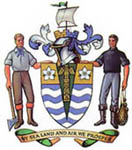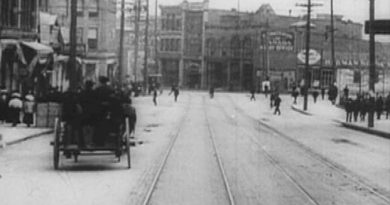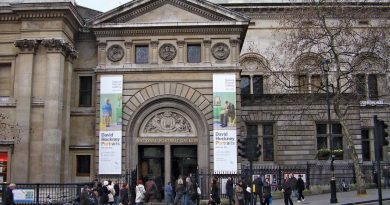Vancouver’s Coat of Arms
Vancouver’s Coat of Arms is based on a design by an artist named James Blomfield . . . whose name is as renowned here for his wonderful works in stained glass. Robert Watt, a stained-glass enthusiast, says that if you stand in Holy Trinity Cathedral in New Westminster on a clear, early morning you will see the three great stained glass windows there on the east wall behind and above the altar begin to glow. “The effect as the sun rises behind those windows,” says Watt, “is extraordinary.”

The window on the left as you face the altar is a memorial to the late Dr. A. W. Sillitoe, the first bishop of the New Westminster Diocese. On the right is a pentecostal scene (depicting the descent of the Holy Spirit on to the apostles) . . . and in the middle is a portrait, in rich reds and golds, of Christ in Majesty.
The man who designed the windows, the late James Blomfield, has more work in stained glass all around the Lower Mainland (and much more in Ontario). Another of his more spectacular and well-known achievements is the beautiful representation of the Three Graces that visitors to Romano’s Macaroni Grill in Vancouver’s West End admire while they dine. Those three windows were designed and installed in 1901 when the house, built by sugar magnate B. T. Rogers, was known as Gabriola. Also Blomfield’s work is the Queen Victoria window in St. Paul’s Anglican Church in Vancouver’s West End.
Perhaps unfairly, the evidence of Blomfield’s artistic talents most often seen by us was the coat of arms for Vancouver that served as the city’s emblem for more than 60 years. He designed it in 1903, and it was used until 1969. Today’s coat of arms, although different and much simpler in design, is based on Blomfield’s original conception. Vancouver’s Coat of Arms was granted by the College of Heralds, London, England on March 31, 1969. The Coat of Arms, the city explains, “represents many of the important parts of our heritage. The shield, with ship’s sail and crown, depicts Vancouver’s location and status as a seaport. The Kwakiutl totem pole shows our Native heritage; the logger and fisherman point to the City’s original industries; and the dogwood flowers are symbols of B.C.”
Blomfield’s stained glass windows were an important part of a special exhibition called Rainbows in Our Walls held at the Vancouver Museum back in 1978.
What’s extraordinary is that all of this gorgeous work came out of a rough workshop in what was then bush at West 10th Avenue and Columbia Street. This was the firm of James’ father, Henry Bloomfield. (Sometime around the turn of the century, James dropped one of the ‘o’s from his surname.) Henry Bloomfield started the first local art glass firm in New Westminster in 1890, and moved in 1898 to Vancouver with his two sons, Charles and James.
Robert Watt learned that James Blomfield was buried in the Hamilton Mausoleum in Hamilton, Ont. But, in a tour of the building with the owner, he also learned the artist’s crypt was unmarked. The owner, W. Stoneham, opened the Blomfield crypt and handed the urn containing the artist’s ashes to a mildly startled Robb Watt. “That was my closest contact to the man,” Watt says. (The crypt also contains the remains of Mary Blomfield, the former Mary Augusta Diamond, whom he married in Vancouver in 1903.)
On his return to Vancouver, Watt began a low-key campaign to get that marker. He contacted various nieces and nephews of the artist and, eventually, a memorial plaque was commissioned for the man Watt describes as “the outstanding Canadian stained glass artist of the pre-1950s period.”
Incidentally, Robb Watt—once the director of the Vancouver Museum—is today the Chief Herald of Canada, appointed to oversee and approve the use of coats of arms in Canada.

![Vancouver Coat of Arms [Image: Wikipedia]](https://vancouverhistory.ca/wp-content/uploads/2021/01/1024px-Coat_of_arms_of_Vancouver.svg_-800x445.png)


